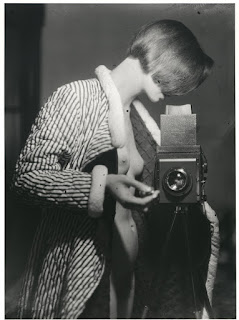Our past and current narcissistic overtures.
(Marianne Breslauer, « Die Fotografin » , 1933, Fotostiftung Schweiz,
Marianne Breslauer Archiv © Marianne Breslauer Archiv/Fotostiftung
Schweiz, Winterthur. All credit due)
What will be interesting about the Yahoo buying Tumblr, a relevantly new internet startup, for 1.1billion is gambling on most probably the narcissistic effect that Tumblr cornered so well on the internet. And yes we are talking about the self pic phenomenon or self porn, which is a beautiful example of the sexual commerce of the internet, leaving the established porn industry and falling into the hands of pure individual narcissism - which is free. The shift from voyeuristic, which has been most probably an all male audience, has now split to females using the idolized reflection of a smart-phone camera. Incredible power shift, described in a term called creative destruction, but commercially void - as far as the user making any money from uploading pictures to Tumblr. The change in sexual dynamics on the internet is significant, especially when our psychological characteristics are reinforced by technology i.e digital cameras. The only things that I can think of at this point to watch; is Yahoo's possible commercialization of Tumblr and the curse of narcissism.
But I am more interested in history and the art behind moments in time, more so modernist and post modernist periods, as we could be repeating parts of history to a T. More so, post World War One, 1920's through to the 1930, which was in so many ways a liberating time for women. Also keeping in mind the clash against feminine power, from men, seems to be increasing - as we all collide into an unknown and possible dark future, with cycles of the past resonating.
From the excellent article: Mirrors, Masks and Spaces. Self-portraits by Women Photographers in the twenties and thirties. By Herbert Molderings & Barbara Mülhens-Molderings
"The social changes during the First
World War gave fresh impetus to the women’s liberation movement. Whilst
the majority of men were conscripted and many lost their lives – or at
least their health – in the war, the survivors returning home without
any sense of purpose or orientation, women had had to take their place
in both public and private life and had done so with enormous initiative
and inventiveness. The self-confidence which women had gained through
these changes no longer fitted in with the social constraints of the
Belle Époque or the Wilhelminian Monarchy, for these changes had been
far too radical. The values of the 19th century had lost all
their validity. Thus it was that a whole generation of men, who first
had to come to terms with their experiences of the war and regain their
place in civilian life, were confronted by the phenomenon of the “New
Woman” in all walks of life, whether as shop assistants or clerks,
artists, photographers or actresses, physicians or writers.
The “New Woman” – also known as a “flapper” or “garçonne”1
– soon epitomized the 1920s and, with her bobbed hairstyle, straight
shift dress and long cigarette holder, was to be found everywhere in
Europe. In Germany, where the Weimar Constitution of 1919 had for the
first time guaranteed women’s suffrage and the right to study at
a university, the “New Woman” was the “epitome of Weimar modernity”,
a symbol “of our Republic’s modern progressiveness, its urbanity, its
enthusiasm for technical advancement, its objectivity and its democratic
image.”2 Otto Dix immortalized her in his famous portrait of
the journalist Sylvia von Harden, painted in 1926 (Coll. Musée national
d’art moderne, Centre Georges Pompidou)."
There could be a similar construct now to the 1920's 'Weimar' period, again this is just reflections from the past and of course I am theorizing. Although it is worth looking for reference points in history, in saying that we could pretty much eliminate large portions of the 1990s, but leaving some creative technological and cultural aspects of the 1980s, 1970s (sans the counter culture revolution/s), 1960s (sans the counter culture revolution/s) and bypass almost completely the 1950s. The 1940s was a global war (WW2) and the beginnings of extreme conservatism (1950s paranoid ant-communism mania and witch-hunts). So we could sit nicely in that resonating time between the 1920s to the late 1930s.
On 1930's narcissism and self - portraits from: Mirrors, Masks and Spaces. Self-portraits by Women Photographers in
the twenties and thirties. By Herbert Molderings & Barbara
Mülhens-Molderings:
A trained photographer like Ergy Landau and Germaine Krull. In
a self-portrait taken in 1933, undoubtedly the most erotic self-portrait
of a woman photographer of the 1920s and 1930s, this Berlin
photographer poses, with her cable release in her hand, as a young woman
obviously skillful at the game of concealing and revealing. She has
deliberately opened her fashionable, fur-trimmed housecoat in order to
view her beautiful naked body on the ground-glass screen of the camera.
As she is standing to one side of the mirror, her face is hidden by her
hair, heightening still further the subtle eroticism of this photograph.
Her gaze into the viewfinder of the camera, as though refusing to look
herself and, by the same token, the imagined viewer in the eye as she
performs her exhibitionist act, seems modest and outdated compared with
the erotic self-portraits of women photographers today.24 At
once narcissistic and voyeuristic, this self-portrait is less an
occupational portrait of the kind intended for publication – we know of
no publication of this photograph prior to 197925 – than
a private study of a young woman photographer using her professional
skills to explore, and take delight in, the eroticism of her appearance.



Comments
Post a Comment